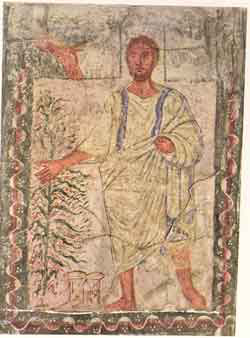Introduction
After the first twelve chapters of the Book of Genesis, the grandeur and glory of Creation narrows down to the complexity of one family’s life. The volatile relationships within this family often overshadow their relationship with God.
Displacement of the first-born son is central to the narratives of Genesis. The family in each generation abrogates the conventional preferential status of the first-born. God plays a minor role in these reversals of status; they are accomplished mainly by the human players, sometimes violently, sometimes petulantly and sometimes by deception.
The story of the early life of Jacob and Esau is no exception. Since Jacob will become Israel, the themes of conflict, displacement and deviousness have special importance here.
One of the most famous portrayals of the early lives of Jacob and Esau is Ghiberti’s panel from the bronze Gates of Paradise in Florence.
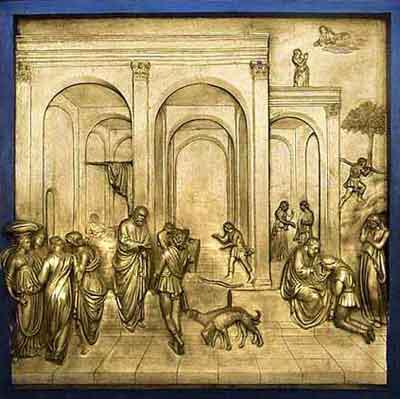
Examination of the panel, however, reveals that it is indifferent to the biblical narrative. For example, one would expect that the figures in high relief represent the major episodes of the saga. But in fact, the women on the left, near the birthing Rebecca, are not mentioned in the Bible; Isaac’s commission of Esau to hunt for him, at the center, is not a major episode. The sale of the firstborn status, which is a critical point in the biblical story, is partially hidden, deep in the background. The most visible part of that scene is a bow, gratuitously suspended within a large open space. It leads our eyes to two finely sculpted dogs, one shaggy and one smooth, representing the brothers, but totally nonbiblical. It seems that Ghiberti, rather than acting as a biblical commentator, was merely using the biblical narrative to project his artistic brilliance. We turn, therefore, to other treatments of the early interaction between Jacob and Esau in order to find evidence of visual interpretation of the biblical story.
Part I: The birth of the twins
(כ) וַיְהִ֤י יִצְחָק֙ בֶּן־אַרְבָּעִ֣ים שָׁנָ֔ה בְּקַחְתּ֣וֹ אֶת־רִבְקָ֗ה בַּת־בְּתוּאֵל֙ הָֽאֲרַמִּ֔י מִפַּדַּ֖ן אֲרָ֑ם אֲח֛וֹת לָבָ֥ן הָאֲרַמִּ֖י ל֥וֹ לְאִשָּֽׁה׃ (כא) וַיֶּעְתַּ֨ר יִצְחָ֤ק לַֽיהֹוָה֙ לְנֹ֣כַח אִשְׁתּ֔וֹ כִּ֥י עֲקָרָ֖ה הִ֑וא וַיֵּעָ֤תֶר לוֹ֙ יְהֹוָ֔ה וַתַּ֖הַר רִבְקָ֥ה אִשְׁתּֽוֹ׃ (כב) וַיִּתְרֹֽצְצ֤וּ הַבָּנִים֙ בְּקִרְבָּ֔הּ וַתֹּ֣אמֶר אִם־כֵּ֔ן לָ֥מָּה זֶּ֖ה אָנֹ֑כִי וַתֵּ֖לֶךְ לִדְרֹ֥שׁ אֶת־יְהֹוָֽה׃ (כג) וַיֹּ֨אמֶר יְהֹוָ֜ה לָ֗הּ שְׁנֵ֤י (גיים) [גוֹיִם֙] בְּבִטְנֵ֔ךְ וּשְׁנֵ֣י לְאֻמִּ֔ים מִמֵּעַ֖יִךְ יִפָּרֵ֑דוּ וּלְאֹם֙ מִלְאֹ֣ם יֶֽאֱמָ֔ץ וְרַ֖ב יַעֲבֹ֥ד צָעִֽיר׃ (כד) וַיִּמְלְא֥וּ יָמֶ֖יהָ לָלֶ֑דֶת וְהִנֵּ֥ה תוֹמִ֖ם בְּבִטְנָֽהּ׃ (כה) וַיֵּצֵ֤א הָרִאשׁוֹן֙ אַדְמוֹנִ֔י כֻּלּ֖וֹ כְּאַדֶּ֣רֶת שֵׂעָ֑ר וַיִּקְרְא֥וּ שְׁמ֖וֹ עֵשָֽׂו׃ (כו) וְאַֽחֲרֵי־כֵ֞ן יָצָ֣א אָחִ֗יו וְיָד֤וֹ אֹחֶ֙זֶת֙ בַּעֲקֵ֣ב עֵשָׂ֔ו וַיִּקְרָ֥א שְׁמ֖וֹ יַעֲקֹ֑ב וְיִצְחָ֛ק בֶּן־שִׁשִּׁ֥ים שָׁנָ֖ה בְּלֶ֥דֶת אֹתָֽם׃
(20) Isaac was forty years old when he took to wife Rebekah, daughter of Bethuel the Aramean of Paddan-aram, sister of Laban the Aramean. (21) Isaac pleaded with יהוה on behalf of his wife, because she was barren; and יהוה responded to his plea, and his wife Rebekah conceived. (22) But the children struggled in her womb, and she said, “If so, why do I exist?” She went to inquire of יהוה, (23) and יהוה answered her,“Two nations are in your womb,Two separate peoples shall issue from your body;One people shall be mightier than the other,And the older shall serve the younger.” (24) When her time to give birth was at hand, there were twins in her womb. (25) The first one emerged red, like a hairy mantle all over; so they named him Esau. (26) Then his brother emerged, holding on to the heel of Esau; so they named him Jacob. Isaac was sixty years old when they were born.
Our story begins with Rebecca. She finally becomes pregnant and turns to God because she is tortured by violent movements in her womb. God tells her that she will bear twins who will become two nations and that the younger will supplant the older.
One of the rare artistic representations of this episode is found in the upper right-hand corner of Ghiberti’s panel.
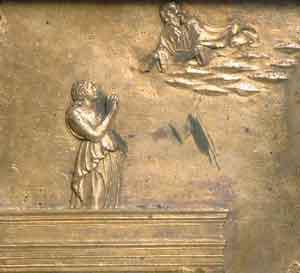
The pregnant Rebecca clasps her hands in prayer; above her, God hovers in a cloud, gesturing in response to her. The very inclusion of this scene in Ghiberti’s panel and its odd placement are indicative of the artist’s capricious attitude toward the biblical material.
Below we will discuss Rebecca’s significance in Christian theology and art. The destiny and character of the twins, Jacob and Esau, are immediately evident in the birth scenes below:
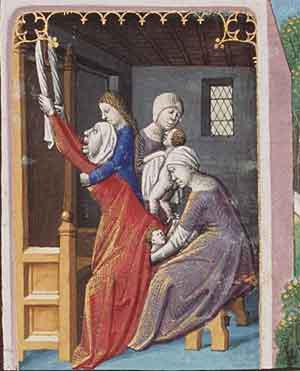
In this illumination from Augustine’s City of God, three midwives attending Rebecca take up most of the space. But in the center, already devious, Jacob emerges from the womb grabbing Esau’s heel.
The contrasting personalities and status of the twins are already evident in the newborns in two contemporaneous manuscripts of the Bible Historiale.
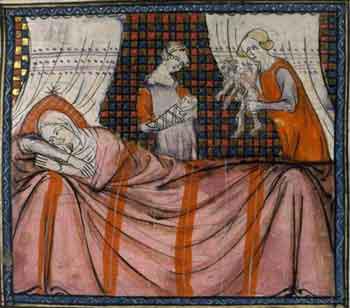
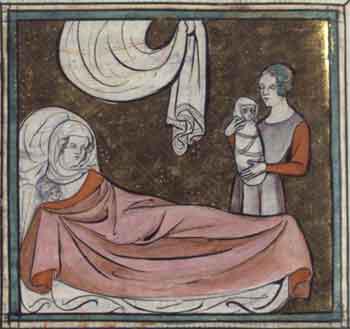
On the left, Jacob is peacefully swaddled, while Esau flails about wildly, already out of control. On the right, Rebecca favors the smaller Jacob at the breast, while the larger Esau is held at a distance.
Within a single frame, the Sarajevo Haggadah illustrates both the birth of the twins and their identities as adults.
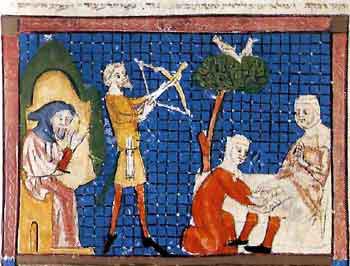
Sarajevo Haggadah, ca. 1350
On the right, Rebecca gives birth to both simultaneously; there is no evidence of a firstborn. On the left, we see the contrasting personalities of Esau, the hunter and Jacob, the Torah scholar. These contrasting characterizations prepare us for the following scene, which flashes the reader forward to the playing out of their destinies.
Part II: The sale of the birthright
(כט) וַיָּ֥זֶד יַעֲקֹ֖ב נָזִ֑יד וַיָּבֹ֥א עֵשָׂ֛ו מִן־הַשָּׂדֶ֖ה וְה֥וּא עָיֵֽף׃ (ל) וַיֹּ֨אמֶר עֵשָׂ֜ו אֶֽל־יַעֲקֹ֗ב הַלְעִיטֵ֤נִי נָא֙ מִן־הָאָדֹ֤ם הָאָדֹם֙ הַזֶּ֔ה כִּ֥י עָיֵ֖ף אָנֹ֑כִי עַל־כֵּ֥ן קָרָֽא־שְׁמ֖וֹ אֱדֽוֹם׃ (לא) וַיֹּ֖אמֶר יַעֲקֹ֑ב מִכְרָ֥ה כַיּ֛וֹם אֶת־בְּכֹרָֽתְךָ֖ לִֽי׃ (לב) וַיֹּ֣אמֶר עֵשָׂ֔ו הִנֵּ֛ה אָנֹכִ֥י הוֹלֵ֖ךְ לָמ֑וּת וְלָמָּה־זֶּ֥ה לִ֖י בְּכֹרָֽה׃ (לג) וַיֹּ֣אמֶר יַעֲקֹ֗ב הִשָּׁ֤בְעָה לִּי֙ כַּיּ֔וֹם וַיִּשָּׁבַ֖ע ל֑וֹ וַיִּמְכֹּ֥ר אֶת־בְּכֹרָת֖וֹ לְיַעֲקֹֽב׃ (לד) וְיַעֲקֹ֞ב נָתַ֣ן לְעֵשָׂ֗ו לֶ֚חֶם וּנְזִ֣יד עֲדָשִׁ֔ים וַיֹּ֣אכַל וַיֵּ֔שְׁתְּ וַיָּ֖קׇם וַיֵּלַ֑ךְ וַיִּ֥בֶז עֵשָׂ֖ו אֶת־הַבְּכֹרָֽה׃ {פ}
(29) Once when Jacob was cooking a stew, Esau came in from the open, famished. (30) And Esau said to Jacob, “Give me some of that red stuff to gulp down, for I am famished”—which is why he was named Edom. (31) Jacob said, “First sell me your birthright.” (32) And Esau said, “I am at the point of death, so of what use is my birthright to me?” (33) But Jacob said, “Swear to me first.” So he swore to him, and sold his birthright to Jacob. (34) Jacob then gave Esau bread and lentil stew; he ate and drank, and he rose and went away. Thus did Esau spurn the birthright.
In this memorable scene, the unscrupulous Jacob takes advantage of his brother’s exhaustion and drives a hard bargain in order to acquire the status of firstborn – a crucial and nontransferable role in biblical society (see Deuteronomy 21:16). Esau the hunter, certainly a slave to his appetites, is indifferent to this prized status, as shown by the laconic series of verbs in verse 34, which equate his eating with his spurning; eat and run.
Literary midrashim of this story tend to read against this peshat. Traditional Jewish sources cast Esau as a villain, thus suggesting by contrast Jacob’s virtues. On the other hand, much of the artwork inserts the parents into the scene, despite their absence from the biblical text.
In order to see how artists interpreted this scene, we will now examine chronologically a series of works of art, beginning with medieval illuminated manuscripts and ending with contemporary photography.
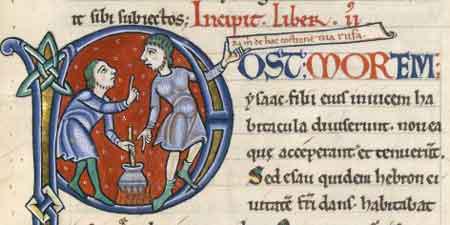
Body language is critical in this early representation of the scene of the sale of the birthright. Placed on either side of a pot cooking above a fire, on a red background reflecting the red stew and Esau’s nickname “Edom”, the two brothers gesture in negotiation. While Esau points downward at the pot with his right hand, asking to be fed (verse 30 – quoted in the banner he holds), Jacob stirs the stew with his left hand and points upward with his right, demanding that Esau swear by God (verse 33). The two brothers represent, then, the material (Esau) and the spiritual (Jacob). They seem to be dancing around the stew.
In this Latin translation of Josephus’ Antiquities, the entire scene is shown within the initial letter P of the words “Post mortem Ysaac = After the death of Isaac”. The placement of the illumination at this point in Josephus’ account is strange, since in the biblical narrative it occurred when Isaac was still alive. The reason for this strange placement is that the story of the birthright is related by Josephus only as a flashback, in his summation of the lives of Jacob and Esau.
Another early 14th century French Bible Historiale portrays the biblical scene as a quiet, domestic event in which Esau, tired from the hunt, enters the home where Jacob seems to be waiting to attend him with the stew.
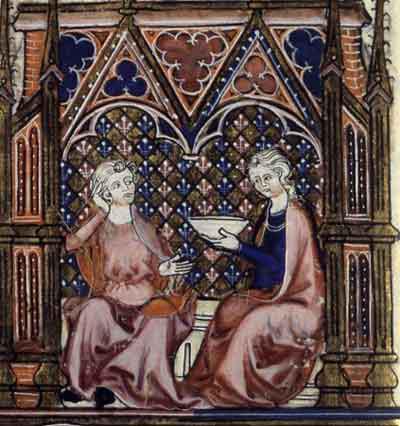
There is no indication of fraternal rivalry or strife, of the negotiations detailed in the biblical text or of the contrasting appearance and occupations of the brothers. Jacob is not mean-spirited or conniving, holding back food from his famished brother. Rather, he seems to immediately comply with Esau’s request. Thus, it would appear that the illustrator of this manuscript, the famed Fauvel Master, wanted to avoid the negative side of Jacob’s character and actions. Why?
In France of the time, issues of succession to the royal throne and rivalry between aristocratic French families in England and France were about to break out into the Hundred Years War. This manuscript abounds with the coats of arms of France and England, reflecting the French contention that both were the dominion of the French monarch. On the other hand, biblical scenes of usurpation are conspicuously absent (cf. Cain and Abel, Isaac and Ishmael, David and Saul, etc.). Thus, not only is the biblical account presented in a manner intended to clean up Jacob’s behavior, out of respect for the Patriarch, but it is harnessed to the agenda of the embattled King of France. Even the caption stresses medieval concepts of hierarchy and property rights; it reads "how Esau sold his first-born rights and presumptive inheritance to his brother Jacob".
32 And Esau said, “I am at the point of death, so of what use is my
birthright to me?”
34 Jacob then gave Esau bread and lentil stew
In the Second Nuremberg Haggadah, the two brothers are found in a rural setting.
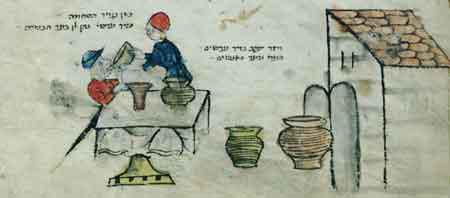
Second Nuremberg Haggadah, South Germany, 1450 - 1500
This folksy version of the biblical story informs us that “Jacob has prepared the stew for himself and others and that here the bargain is accomplished.”
ויזד יעקב נזיד עדשים, בעדו ובעד האנשים כאן נגמר הסחורה נזיד עדשים נתן לו בעד הבכורה
Shrewd Jacob pours a large bowl of stew into the mouth of the bearded and oafish Esau. This portrayal of the scene embodies the traditional understanding of the hapax (a one time use of the root in the Bible) הלעיטני , as in Rashi’s comment on the word:
I will open my mouth and you will pour a lot into it, as we have
learned in a Mishnah: A camel may not be force-fed but food may
be poured into him.
Jacob’s hard sell is entirely missing.
In the Speculum Historiale of 1463, Esau wearing a hunter’s hat, holds out one hand, while patting his stomach with his other hand, indicating “Give me some of that red stuff to gulp down, for I am famished” (verse 30).
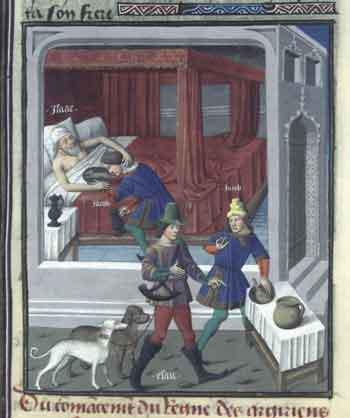
While he is equipped with hunter’s gear, he is neither hairy nor ruddy in appearance. Jacob, wearing a different type of hat, withholds the food with one hand and gestures with the other to slow the action, in accordance with the next words of the text, “First sell me your birthright”. Behind Esau stand two dogs, a motif that we have already seen in Ghiberti’s panel. One dog is white and sleek, the other is dark and bulky – characterizing the two brothers. This rendition seems to be an attempt at a literal/accurate portrayal of the text, appropriate for an encyclopedia such as the Speculum Historiale, and unlike the earlier illuminated manuscripts.
Medieval illuminations are like comics; they portray types rather than individuals. Artistic sensitivities are vastly different two centuries later; witness the Dutch baroque artist Hendrick ter Brugghen in the 17th century
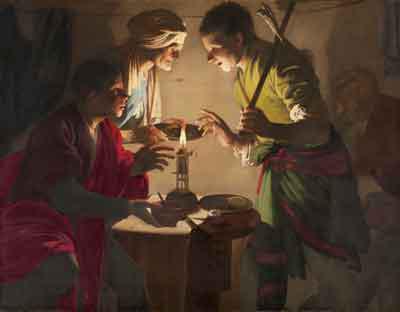
Real people now constitute the biblical family. Jacob, dressed in red (alluding to the red lentils), sits at a tiny table on which a single candle lights the interior of their home. One hand gesticulates, while the other holds out a small bowl of food. Esau faces him, carrying a staff and his latest catch. He too gestures. There is no clear physical difference between the brothers, despite the biblical descriptions. Preoccupied by their conversation, they pay no attention to Rebecca, who passes by, bringing a bowl of soup for Isaac, who sits alone in the darkness. Her hands and the bowl create the only physical link between her sons. The parents are included by ter Brugghen, despite their absence from the biblical account. Rebeccah overhears her sons’ conversation, preparing her for her coming role. Isaac is out to lunch. The artist uses the Dutch genre of family interiors ironically to indicate the emotional distance between the characters, despite their physical proximity.
In the following generation, Rembrandt drew this scene several times over the course of his career. His latest version of the biblical scene deals with the earliest phase of the narrative.
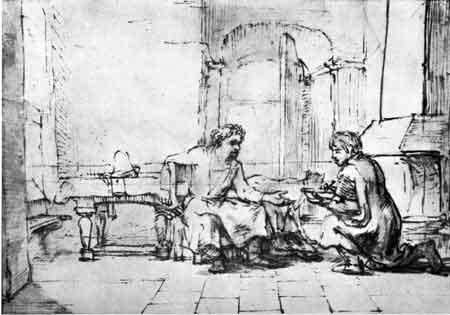
Rembrandt, 1655
The bearded, burly Esau has just come in, the door is still open; he flops down on a chair, having flung his hat on the table. His right arm is draped nonchalantly around the chair and his left is extended, impatient for food. Jacob kneels in front of Esau timidly, holding the bowl of stew, symbolic of his subservient position in the family. Once again, between the two brothers are two dogs, one lying at Esau’s feet and the other standing behind him. Together the dogs link the two brothers, as Rebecca linked them in ter Brugghen’s painting. We see the scene from the far side of the room, thus allowing us a view of the interior of the brothers’ substantial home, a well-to-do Dutch interior. There is no visible tension; Esau is simply the lord waiting for the servant to respond. He does not yet know that the tables will be turned.
In Rembrandt’s portrayal of the later part of the scene, the passive Jacob has become dominant.
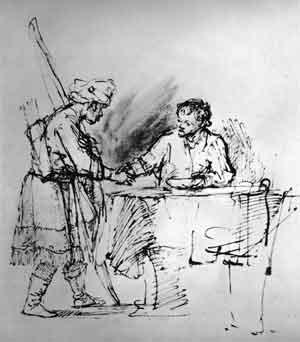
He is seated at a table, holding the bowl of stew close to his chest. Although exhausted, Esau stands, still holding his hunting equipment. Esau looks like a dumb peasant, while Jacob is a shrewd gambler. Here we have no comfortable interior; Rembrandt focuses us entirely on the two figures and the table, filling the space between the two with agitated, dark lines, indicating the troubled atmosphere. The two brothers shake hands. Although not in the biblical account, this handshake represents Esau’s vow to sell his birthright cheap. It’s a done deal and Esau never got to sit down.
Jumping forward to the twentieth century, idiosyncratic Stanley Spencer shows little interest in the story of the birthright.
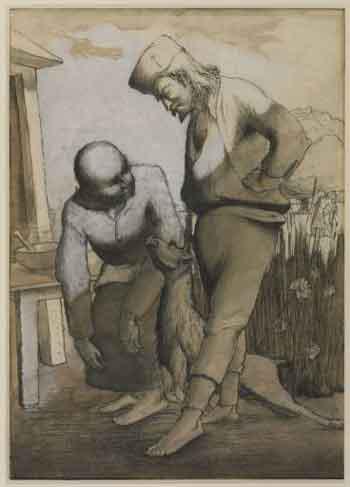
He presents bearded and long-haired Esau, having just arrived from the hunt with his prey, hand on hip in a self-congratulatory stance. He shows off to Jacob, his apron-wearing bald twin, who crouches down to see the catch, his long arms dangling awkwardly. Jacob’s gaze avoids eye contact. Spencer focuses solely on Esau’s superior position and Jacob’s role as a “housewife”.
Israeli photographer Adi Ness portrays his biblical characters as the dregs of society. We are disabused of any preconceived notion of nobility.
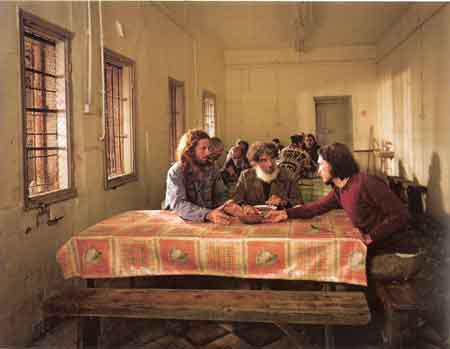
For the birthright scene, he brings us into a dreary, contemporary soup kitchen. The exposed wall sockets, the iron bars on the windows and the oil cloth on the table are part of the stark poverty of the scene.
Good-looking Esau, identified by his long, red hair and beard, is about to take the stew from Jacob, who is not quite ready to release the bowl. The spoon is still near him on the table.
Enigmatically, a third character sits between them, with his own bowl of stew. He looks at Jacob quizzically, not understanding the hesitation. Apparently, contrary to the biblical account, the artist has brought a parent to the dinner table. Unlike ter Brugghen, it is not Rebecca, but Isaac; this is a world of destitute men. Like ter Brugghen, the parent serves as the contact point between the two brothers. The biblical episode is dealing with the struggle between the two brothers over control of the family property; Adi Ness’ characters have no property or hope.
Part III: The theft of the blessing
The commissioning scene
(א) וַֽיְהִי֙ כִּֽי־זָקֵ֣ן יִצְחָ֔ק וַתִּכְהֶ֥יןָ עֵינָ֖יו מֵרְאֹ֑ת וַיִּקְרָ֞א אֶת־עֵשָׂ֣ו ׀ בְּנ֣וֹ הַגָּדֹ֗ל וַיֹּ֤אמֶר אֵלָיו֙ בְּנִ֔י וַיֹּ֥אמֶר אֵלָ֖יו הִנֵּֽנִי׃ (ב) וַיֹּ֕אמֶר הִנֵּה־נָ֖א זָקַ֑נְתִּי לֹ֥א יָדַ֖עְתִּי י֥וֹם מוֹתִֽי׃ (ג) וְעַתָּה֙ שָׂא־נָ֣א כֵלֶ֔יךָ תֶּלְיְךָ֖ וְקַשְׁתֶּ֑ךָ וְצֵא֙ הַשָּׂדֶ֔ה וְצ֥וּדָה לִּ֖י (צידה) [צָֽיִד]׃ (ד) וַעֲשֵׂה־לִ֨י מַטְעַמִּ֜ים כַּאֲשֶׁ֥ר אָהַ֛בְתִּי וְהָבִ֥יאָה לִּ֖י וְאֹכֵ֑לָה בַּעֲב֛וּר תְּבָרֶכְךָ֥ נַפְשִׁ֖י בְּטֶ֥רֶם אָמֽוּת׃ (ה) וְרִבְקָ֣ה שֹׁמַ֔עַת בְּדַבֵּ֣ר יִצְחָ֔ק אֶל־עֵשָׂ֖ו בְּנ֑וֹ וַיֵּ֤לֶךְ עֵשָׂו֙ הַשָּׂדֶ֔ה לָצ֥וּד צַ֖יִד לְהָבִֽיא׃
(1) When Isaac was old and his eyes were too dim to see, he called his older son Esau and said to him, “My son.” He answered, “Here I am.” (2) And he said, “I am old now, and I do not know how soon I may die. (3) Take your gear, your quiver and bow, and go out into the open and hunt me some game. (4) Then prepare a dish for me such as I like, and bring it to me to eat, so that I may give you my innermost blessing before I die.” (5) Rebekah had been listening as Isaac spoke to his son Esau. When Esau had gone out into the open to hunt game to bring home,
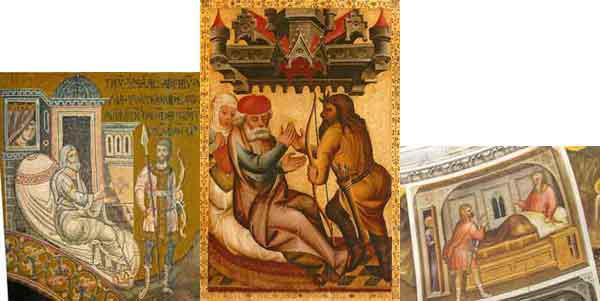
Cathedral of Monreale Meister Bertram, Giusto de Menabuoi,
12th century 1375-83 Padua Baptistery,
1320-91
Mothers play a crucial though covert role in the unfolding of the patriarchal family saga throughout Genesis. Sarah and Hagar, Rachel and Leah. But it is Rebecca who stands out in her formulation and orchestration of Jacob’s displacement of Esau, especially in the story of the blessings.
In all three of the works above, from the late middle ages, three characters appear in the commissioning scene: Isaac, Esau and Rebecca. Isaac is passive, reclining or bed-ridden; only in Meister Bertram’s treatment is he noticeably blind. In all three, Esau is bearded and equipped with bow and arrows; in Meister Bertram’s altarpiece, however, he looks satanic, resembling the evil Cain, from an earlier panel.
In the biblical text, Rebecca’s presence is hidden from the reader, until the commissioning has been completed. In the art, Rebecca is seen overhearing the conversation between Isaac and Esau, but her characterization varies. In Monreale, she appears at a distance through an open window; in Giusto’s mural, she lurks nearby in the doorway; in Meister Bertram, super-pious she stands right behind her aged husband, dutifully present. Thus these artists stress Rebecca’s “hidden” presence in this scene; paradoxically, Ghiberti leaves her out of this forward most scene in his panel, despite her belated disclosure of her presence in the biblical account.
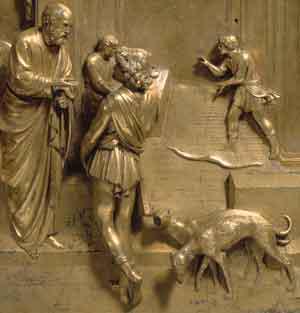
Her absence here is particularly striking in light of her multiple appearances throughout the panel. Is it possible that Esau’s bow, lying strangely in an open space dead-center, is intended to look like a serpent, suggesting Rebecca’s cunning?
The Plot and the Theft
(ה) וְרִבְקָ֣ה שֹׁמַ֔עַת בְּדַבֵּ֣ר יִצְחָ֔ק אֶל־עֵשָׂ֖ו בְּנ֑וֹ וַיֵּ֤לֶךְ עֵשָׂו֙ הַשָּׂדֶ֔ה לָצ֥וּד צַ֖יִד לְהָבִֽיא׃ (ו) וְרִבְקָה֙ אָֽמְרָ֔ה אֶל־יַעֲקֹ֥ב בְּנָ֖הּ לֵאמֹ֑ר הִנֵּ֤ה שָׁמַ֙עְתִּי֙ אֶת־אָבִ֔יךָ מְדַבֵּ֛ר אֶל־עֵשָׂ֥ו אָחִ֖יךָ לֵאמֹֽר׃ (ז) הָבִ֨יאָה לִּ֥י צַ֛יִד וַעֲשֵׂה־לִ֥י מַטְעַמִּ֖ים וְאֹכֵ֑לָה וַאֲבָרֶכְכָ֛ה לִפְנֵ֥י יְהֹוָ֖ה לִפְנֵ֥י מוֹתִֽי׃ (ח) וְעַתָּ֥ה בְנִ֖י שְׁמַ֣ע בְּקֹלִ֑י לַאֲשֶׁ֥ר אֲנִ֖י מְצַוָּ֥ה אֹתָֽךְ׃ (ט) לֶךְ־נָא֙ אֶל־הַצֹּ֔אן וְקַֽח־לִ֣י מִשָּׁ֗ם שְׁנֵ֛י גְּדָיֵ֥י עִזִּ֖ים טֹבִ֑ים וְאֶֽעֱשֶׂ֨ה אֹתָ֧ם מַטְעַמִּ֛ים לְאָבִ֖יךָ כַּאֲשֶׁ֥ר אָהֵֽב׃ (י) וְהֵבֵאתָ֥ לְאָבִ֖יךָ וְאָכָ֑ל בַּעֲבֻ֛ר אֲשֶׁ֥ר יְבָרֶכְךָ֖ לִפְנֵ֥י מוֹתֽוֹ׃ (יא) וַיֹּ֣אמֶר יַעֲקֹ֔ב אֶל־רִבְקָ֖ה אִמּ֑וֹ הֵ֣ן עֵשָׂ֤ו אָחִי֙ אִ֣ישׁ שָׂעִ֔ר וְאָנֹכִ֖י אִ֥ישׁ חָלָֽק׃ (יב) אוּלַ֤י יְמֻשֵּׁ֙נִי֙ אָבִ֔י וְהָיִ֥יתִי בְעֵינָ֖יו כִּמְתַעְתֵּ֑עַ וְהֵבֵאתִ֥י עָלַ֛י קְלָלָ֖ה וְלֹ֥א בְרָכָֽה׃ (יג) וַתֹּ֤אמֶר לוֹ֙ אִמּ֔וֹ עָלַ֥י קִלְלָתְךָ֖ בְּנִ֑י אַ֛ךְ שְׁמַ֥ע בְּקֹלִ֖י וְלֵ֥ךְ קַֽח־לִֽי׃ (יד) וַיֵּ֙לֶךְ֙ וַיִּקַּ֔ח וַיָּבֵ֖א לְאִמּ֑וֹ וַתַּ֤עַשׂ אִמּוֹ֙ מַטְעַמִּ֔ים כַּאֲשֶׁ֖ר אָהֵ֥ב אָבִֽיו׃ (טו) וַתִּקַּ֣ח רִ֠בְקָ֠ה אֶת־בִּגְדֵ֨י עֵשָׂ֜ו בְּנָ֤הּ הַגָּדֹל֙ הַחֲמֻדֹ֔ת אֲשֶׁ֥ר אִתָּ֖הּ בַּבָּ֑יִת וַתַּלְבֵּ֥שׁ אֶֽת־יַעֲקֹ֖ב בְּנָ֥הּ הַקָּטָֽן׃ (טז) וְאֵ֗ת עֹרֹת֙ גְּדָיֵ֣י הָֽעִזִּ֔ים הִלְבִּ֖ישָׁה עַל־יָדָ֑יו וְעַ֖ל חֶלְקַ֥ת צַוָּארָֽיו׃ (יז) וַתִּתֵּ֧ן אֶת־הַמַּטְעַמִּ֛ים וְאֶת־הַלֶּ֖חֶם אֲשֶׁ֣ר עָשָׂ֑תָה בְּיַ֖ד יַעֲקֹ֥ב בְּנָֽהּ׃ (יח) וַיָּבֹ֥א אֶל־אָבִ֖יו וַיֹּ֣אמֶר אָבִ֑י וַיֹּ֣אמֶר הִנֶּ֔נִּי מִ֥י אַתָּ֖ה בְּנִֽי׃ (יט) וַיֹּ֨אמֶר יַעֲקֹ֜ב אֶל־אָבִ֗יו אָנֹכִי֙ עֵשָׂ֣ו בְּכֹרֶ֔ךָ עָשִׂ֕יתִי כַּאֲשֶׁ֥ר דִּבַּ֖רְתָּ אֵלָ֑י קֽוּם־נָ֣א שְׁבָ֗ה וְאׇכְלָה֙ מִצֵּידִ֔י בַּעֲב֖וּר תְּבָרְכַ֥נִּי נַפְשֶֽׁךָ׃ (כ) וַיֹּ֤אמֶר יִצְחָק֙ אֶל־בְּנ֔וֹ מַה־זֶּ֛ה מִהַ֥רְתָּ לִמְצֹ֖א בְּנִ֑י וַיֹּ֕אמֶר כִּ֥י הִקְרָ֛ה יְהֹוָ֥ה אֱלֹהֶ֖יךָ לְפָנָֽי׃ (כא) וַיֹּ֤אמֶר יִצְחָק֙ אֶֽל־יַעֲקֹ֔ב גְּשָׁה־נָּ֥א וַאֲמֻֽשְׁךָ֖ בְּנִ֑י הַֽאַתָּ֥ה זֶ֛ה בְּנִ֥י עֵשָׂ֖ו אִם־לֹֽא׃ (כב) וַיִּגַּ֧שׁ יַעֲקֹ֛ב אֶל־יִצְחָ֥ק אָבִ֖יו וַיְמֻשֵּׁ֑הוּ וַיֹּ֗אמֶר הַקֹּל֙ ק֣וֹל יַעֲקֹ֔ב וְהַיָּדַ֖יִם יְדֵ֥י עֵשָֽׂו׃ (כג) וְלֹ֣א הִכִּיר֔וֹ כִּֽי־הָי֣וּ יָדָ֗יו כִּידֵ֛י עֵשָׂ֥ו אָחִ֖יו שְׂעִרֹ֑ת וַֽיְבָרְכֵֽהוּ׃ (כד) וַיֹּ֕אמֶר אַתָּ֥ה זֶ֖ה בְּנִ֣י עֵשָׂ֑ו וַיֹּ֖אמֶר אָֽנִי׃ (כה) וַיֹּ֗אמֶר הַגִּ֤שָׁה לִּי֙ וְאֹֽכְלָה֙ מִצֵּ֣יד בְּנִ֔י לְמַ֥עַן תְּבָֽרֶכְךָ֖ נַפְשִׁ֑י וַיַּגֶּשׁ־לוֹ֙ וַיֹּאכַ֔ל וַיָּ֧בֵא ל֦וֹ יַ֖יִן וַיֵּֽשְׁתְּ׃ (כו) וַיֹּ֥אמֶר אֵלָ֖יו יִצְחָ֣ק אָבִ֑יו גְּשָׁה־נָּ֥א וּשְׁקָה־לִּ֖י בְּנִֽי׃ (כז) וַיִּגַּשׁ֙ וַיִּשַּׁק־ל֔וֹ וַיָּ֛רַח אֶת־רֵ֥יחַ בְּגָדָ֖יו וַֽיְבָרְכֵ֑הוּ וַיֹּ֗אמֶר רְאֵה֙ רֵ֣יחַ בְּנִ֔י כְּרֵ֣יחַ שָׂדֶ֔ה אֲשֶׁ֥ר בֵּרְכ֖וֹ יְהֹוָֽה׃ (כח) וְיִֽתֶּן־לְךָ֙ הָאֱלֹהִ֔ים מִטַּל֙ הַשָּׁמַ֔יִם וּמִשְׁמַנֵּ֖י הָאָ֑רֶץ וְרֹ֥ב דָּגָ֖ן וְתִירֹֽשׁ׃ (כט) יַֽעַבְד֣וּךָ עַמִּ֗ים (וישתחו) [וְיִֽשְׁתַּחֲו֤וּ] לְךָ֙ לְאֻמִּ֔ים הֱוֵ֤ה גְבִיר֙ לְאַחֶ֔יךָ וְיִשְׁתַּחֲו֥וּ לְךָ֖ בְּנֵ֣י אִמֶּ֑ךָ אֹרְרֶ֣יךָ אָר֔וּר וּֽמְבָרְכֶ֖יךָ בָּרֽוּךְ׃
(5) Rebekah had been listening as Isaac spoke to his son Esau. When Esau had gone out into the open to hunt game to bring home, (6) Rebekah said to her son Jacob, “I overheard your father speaking to your brother Esau, saying, (7) ‘Bring me some game and prepare a dish for me to eat, that I may bless you, with יהוה’s approval, before I die.’ (8) Now, my son, listen carefully as I instruct you. (9) Go to the flock and fetch me two choice kids, and I will make of them a dish for your father, such as he likes. (10) Then take it to your father to eat, in order that he may bless you before he dies.” (11) Jacob answered his mother Rebekah, “But my brother Esau is a hairy man and I am smooth-skinned. (12) If my father touches me, I shall appear to him as a trickster and bring upon myself a curse, not a blessing.” (13) But his mother said to him, “Your curse, my son, be upon me! Just do as I say and go fetch them for me.” (14) He got them and brought them to his mother, and his mother prepared a dish such as his father liked. (15) Rebekah then took the best clothes of her older son Esau, which were there in the house, and had her younger son Jacob put them on; (16) and she covered his hands and the hairless part of his neck with the skins of the kids. (17) Then she put in the hands of her son Jacob the dish and the bread that she had prepared. (18) He went to his father and said, “Father.” And he said, “Yes, which of my sons are you?” (19) Jacob said to his father, “I am Esau, your first-born; I have done as you told me. Pray sit up and eat of my game, that you may give me your innermost blessing.” (20) Isaac said to his son, “How did you succeed so quickly, my son?” And he said, “Because your God יהוה granted me good fortune.” (21) Isaac said to Jacob, “Come closer that I may feel you, my son—whether you are really my son Esau or not.” (22) So Jacob drew close to his father Isaac, who felt him and wondered. “The voice is the voice of Jacob, yet the hands are the hands of Esau.” (23) He did not recognize him, because his hands were hairy like those of his brother Esau; and so he blessed him. (24) He asked, “Are you really my son Esau?” And when he said, “I am,” (25) he said, “Serve me and let me eat of my son’s game that I may give you my innermost blessing.” So he served him and he ate, and he brought him wine and he drank. (26) Then his father Isaac said to him, “Come close and kiss me, my son”; (27) and he went up and kissed him. And he smelled his clothes and he blessed him, saying, “Ah, the smell of my son is like the smell of the fields that יהוה has blessed. (28) “May God give you Of the dew of heaven and the fat of the earth, Abundance of new grain and wine. (29) Let peoples serve you, And nations bow to you; Be master over your brothers, And let your mother’s sons bow to you. Cursed be they who curse you, Blessed they who bless you.”

Cathedral of Monreale, 12th century
The mosaics of Monreale are the earliest representations in our collection. We were surprised to see Rebecca starring in five panels, as opposed to Sarah, who appears only once and Rachel, Leah, Hagar and other female characters - not at all. Some of the Rebecca scenes are strange, as if the artist was looking for ways to star her. Indeed, Rebecca is emphasized in Christian writings because only she is identified as a virgin among all the women in Genesis, linking her to the Virgin Mary. This accounts for Rebecca’s leading role in Monreale, as a prefiguration of Mary’s prime role in the salvation of humankind.
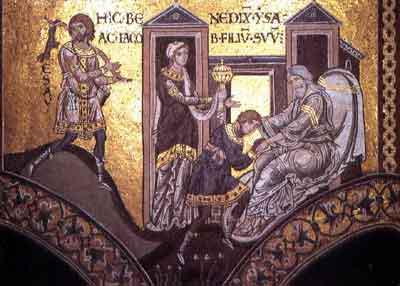
In light of the above, Rebecca at center stage of the blessing scene is no surprise, although the biblical text itself makes no mention of her. In fact, she is present in all of the artistic renditions of this scene. In Monreale, she stands in a doorway holding Isaac’s meal, while Jacob kneels before his father. This is Jacob’s first appearance in the Monreale mosaics – he looks up at Isaac, anxiously. The robust Isaac feels Jacob’s hand and neck to verify his identity.
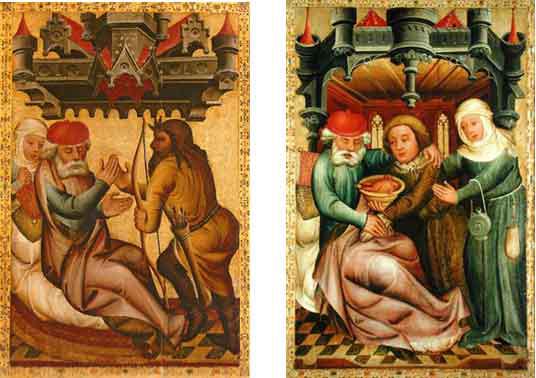
Esau Jacob
As already noted, two panels on Jacob and Esau appear in Meister Bertram’s Grabower Altarpiece. On the right, Isaac and Rebecca frame the innocent-looking Jacob, their arms merging both behind and in front of him in a collective embrace Meister Bertram has transformed the biblical text that actually describes Isaac’s suspicious examination of the “false Esau” into an affirmation of Rebecca’s saintly activity. She pushes Jacob toward his father’s embrace, duping the blind Isaac into making the “right” choice, and thus avoiding the disaster of Esau’s domination. As in Monreale, Rebecca’s role is a prefiguration of the Virgin Mary as the healer of Eve’s mischief. In comparison, although three figures also appear in the scene of Esau’s commission (on the left), it is not a unified trio, but rather the patriarch and the matriarch standing together against the evil son.
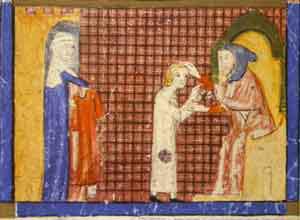
Sarajevo Haggadah, 1350
In the Sarajevo Haggadah, Rebecca stands in the doorway, holding Jacob’s street clothes, while Jacob, standing before Isaac, has donned Esau’s immaculate finery. In Genesis Rabbah we also read: “She accompanied him [Jacob] to the door, saying, ‘I brought you this far; now may God do the rest” (BR 65,17). Although Rebecca is present in the scene. as in Monreale and Meister Bertram, this haggadah limits her involvement and gives God the decisive role in Jacob’s becoming the national progenitor. Thus Jewish piety like Christian piety makes the wily Rebecca into a saint, but for different purposes. Isaac, doubting Jacob’s identity with his left hand, nevertheless blesses him with his right hand.
The most puzzling and astonishing picture that we’ve come across is Jan Sanders van Hemessen’s nightmarish “Isaac blessing Jacob”.
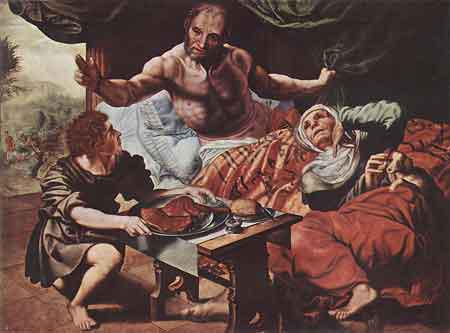
But the drama we see just doesn’t fit this title. Hardly on his death bed, muscular Isaac rises in fury, holding onto the curtains with his left hand and gesturing above Jacob’s head with his right. Jacob, undisguised, kneels by a table, holding a plate with the intended meal for his father and looks up in fright. Rebecca, sprawled on the bed, points to herself while stroking a puppy. In the distance, we see Esau returning unsuspecting from his hunt. Hardly a blessing scene, it is most likely the worst-case scenario that Jacob had imagined when first approached by his mother:
12 If my father touches me, I shall appear to him as a
trickster and bring upon myself a curse, not a blessing.” 13
But his mother said to him, “Your curse, my son, be upon
me!”
This is the only example we have found of the artist portraying what could have happened, rather than what did happen. It is characteristic of van Hemessen’s tendency to stress the dark side of human behavior.
It seems that Rembrandt may have found this scene so distasteful that the blessing doesn’t happen.
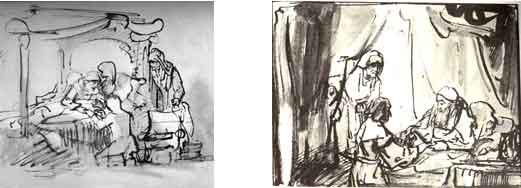
In both of the drawings above, Isaac appears too weak to act/speak. He holds Jacob’s hand in both drawings; the other hand is either lost in the covers or just barely raised from them. What is most curious is that Jacob is a non-person. In the one drawing, his head and much of his body are merely a blank outline. In the second drawing, Jacob’s body is more articulated, but his face is blacked out. Rebecca, in both cases, is very present, watchful and bent in anticipation, but nothing is happening. Is Rembrandt protesting against the deception?
Govert Flinck, a student of Rembrandt, painted in his master’s early style, when the great artist was more concerned with technique and drama than with psychological depth.
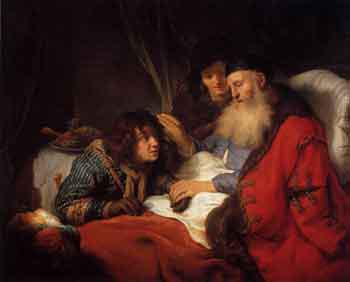
Jacob looks up anxiously at his father’s right hand, wondering whether he is about to receive a blessing or a smack. Rebecca, breathing down Isaac’s neck, looks encouraging and hopeful.
In the final two, semi-modern renditions, suspense regarding the blessing dominates.
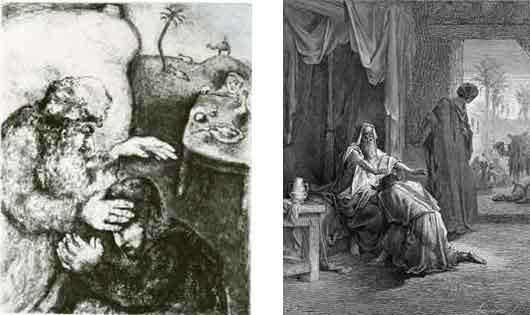
Dore has Isaac, sitting up on the edge of his bed, extending his hands in blessing over Jacob, whose head is buried in his father’s lap. Rebecca is silhouetted in the doorway, anxiously on the lookout for Esau’s return. Marc Chagall views our scene as the crucial point in the working out of Jewish destiny. The aged shtetl saint Isaac sits up in bed and blesses his chosen son, Jacob. At a distance, Rebecca crouches behind the set table as her plan unfolds. From afar we see the past and the future intersect: the young Rebecca approaches, mounted on a camel to meet Isaac, while Jacob sleeps at the foot of a tree, representing his coming ladder dream.
Esau’s humiliation
30 No sooner had Jacob left the presence of his father Isaac—after Isaac had finished blessing Jacob—than his brother Esau came back from his hunt. 31 He too prepared a dish and brought it to his father. And he said to his father, “Let my father sit up and eat of his son’s game, so that you may give me your innermost blessing.” 32 His father Isaac said to him, “Who are you?” And he said, “I am your son, Esau, your first-born!” 33 Isaac was seized with very violent trembling. “Who was it then,” he demanded, “that hunted game and brought it to me? Moreover, I ate of it before you came, and I blessed him; now he must remain blessed!” 34 When Esau heard his father’s words, he burst into wild and bitter sobbing, and said to his father, “Bless me too, Father!” 35 But he answered, “Your brother came with guile and took away your blessing.” 36 [Esau] said, “Was he, then, named Jacob that he might supplant me these two times? First he took away my birthright and now he has taken away my blessing!” And he added, “Have you not reserved a blessing for me?” 37 Isaac answered, saying to Esau, “But I have made him master over you: I have given him all his brothers for servants, and sustained him with grain and wine. What, then, can I still do for you, my son?” 38 And Esau said to his father, “Have you but one blessing, Father? Bless me too, Father!” And Esau wept aloud. 39 And his father Isaac answered, saying to him,
“See, your abode shall enjoy the fat of the earth
And the dew of heaven above.
40 Yet by your sword you shall live,
And you shall serve your brother;
But when you grow restive,
You shall break his yoke from your neck.” Genesis 27
Unlike most of the other artistic treatments of our story, the Morgan Bible illustrates both Jacob’s blessing and Esau’s rejection.
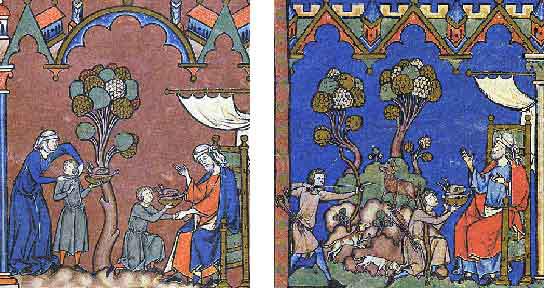
A single tall tree separates Jacob’s blessing into two parts: Rebecca disguising him and Isaac blessing him. Despite the high drama, the bland background creates a deceptive quiet tone. Compare the turmoil in the parallel scene; there is hardly an empty space in the bright blue background. Two trees on a hill parallel the two Esau’s and the two dogs, below. The wild hunting scene anticipates Isaac’s horror when the real Esau arrives. The most dramatic change in the two panels is found paradoxically in Isaac’s static position. The calm, bent head blessing Jacob is raised in anguish and bewilderment with Esau.
Another before and after are the two paintings attributed to Giotto.
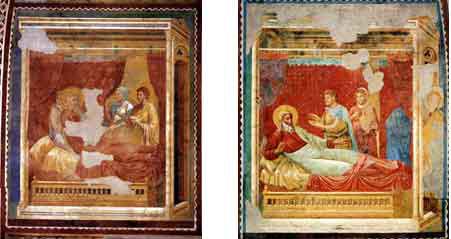
Giotto (?), 1266 - 1337
Four figures occupy one scene; five the other. On the left, Giotto has invented a maidservant who supports the aged and blind Isaac from behind, in order to emphasize his infirmity. Isaac, looking agitated feels Jacob’s disguised hand. Rebecca and Jacob are tense as the blessing proceeds. In the companion scene, the haloed Isaac sits up unsupported in alarm as the handsome Esau presents his offering. The servant girl, now standing in place of Rebecca, also expresses alarm. Rebecca, a torso in blue, heads for the doorway, preceded by Jacob, identifiable only by his faded halo. While these halos are a left-over of Byzantine orthodoxy, faces and movements express Giotto’s interest in drama, anticipating the Renaissance.
Rembrandt, the master of characterization, expresses the turmoil of this scene mainly through a pattern of sharp lines that fill the room.
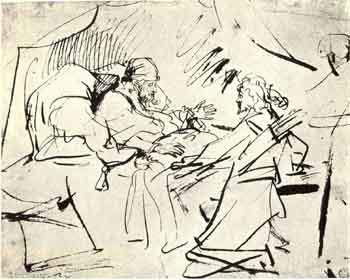
The sharpness is further echoed in Esau’s pointed beard, his garment and his quiver of arrows, as well as in Isaac’s fingers. Thus, Rembrandt is most fascinated by the strong emotions of our scene.
In looking back on the various episodes of the early life of Jacob and Esau and on the many artistic renditions of them, we can see that like written Midrash, many of the artists go to great pains to rehabilitate Jacob and Rebecca and to vilify Esau. Others, however – especially in modern times – reject the orthodox agenda and insist on portraying raw reality or even in pillorying the “saints”.
For additional images on this subject see TALI Visual Midrash



